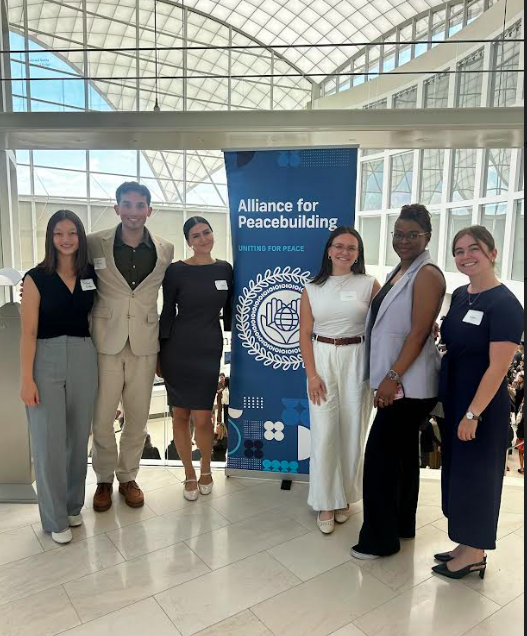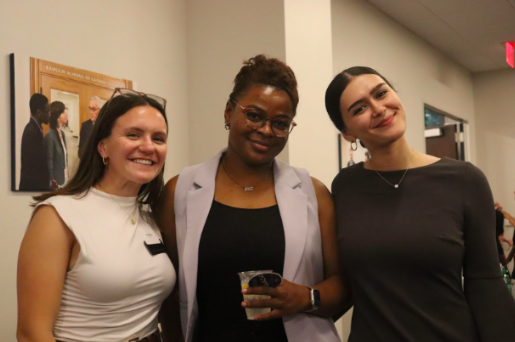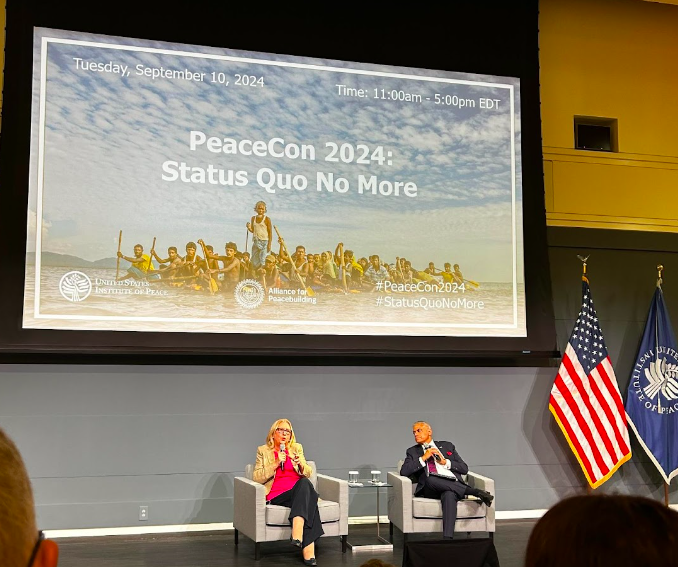Reflections on a Status Quo No More
From September 10-12, all of the current Scoville fellows attended Alliance for Peacebuilding’s annual conference, PeaceCon. The theme of this year’s event was “Status Quo No More”, with conference plenaries addressing topics as ranging as leadership in Northern Ireland, environmental peacebuilding in Yemen, technology-facilitated gender based violence, and approaches to monitoring and evaluation of the Global Fragility Act.
Following the conference, each fellow reflected on one topic or theme that stood out to them from the sessions they attended. While each had many things to share, we asked them to keep their reflections focused on something relevant to their fellowship or their personal research interests. Their reflections are below.

Marlena Broeker, Center for Arms Control and Nonproliferation
As someone who is only just beginning my career in the nuclear non-proliferation and arms control community, I have a long way to go in understanding the strength of passion and belief it takes to forge progress on any global problem. Two speakers from PeaceCon helped me to gain a better understanding of what two different versions of personal investment and passion in problem solving look like.
The first was keynote speaker Mary McAleese, former president of Ireland, who underlined the importance of her deeply personal connection to The Troubles as someone who grew up Catholic in a largely Protestant neighborhood in Northern Ireland. She wove together the story of how her background of being surrounded by people who had been taught to hate each other helped her to understand the value of talking to everyone and being willing to involve everyone, not just your friends, in the solution. McAleese represents the kind of peacemaker that pushes back on old beliefs and systems and uses her passion and personal investment to push towards better ones.
The second was Brittany Brown from the Bureau of Conflict Prevention and Stabilization at USAID who spoke about the Global Fragility Act (GFA). The GFA was signed into law in 2020, and while many saw it as a historical victory for the peacebuilding field as it creates a new tool to prevent and reduce violent conflict around the world, some have been disappointed by the GFA’s subsequent impact and implementation struggles. Brittany however, was beaming with excitement and highlighted one story of a community eliminating violence between cow herders and farmers with the help of the GFA. Seeing her enthusiasm for this story and its eventual success allowed me to see the pragmatism Brittany uses to support communities in her daily work by utilizing the bureaucracy around her to its fullest potential.
My final takeaway would be this: when you consider both of their positions and approaches, Mary McAleese and Brittany Brown represent two different kinds of peacemakers, and we need both. The Scoville Fellowship is meant to welcome all different kinds of thinkers and movers and Mary and Brittany are examples of why this diversity (in both thought and action) is so important for creating a more peaceful and just world.
Grace Connors, ReThink Media
As a digital peacebuilder, the presentation by professors Peter Coleman and Larry Liebovitch on their Sustaining Peace Project stood out strongly to me. They explained how the impetus for their research came from an understanding that “peace is studied in pieces,” meaning that as a discipline, peace studies is largely siloed within the context of individual conflicts and wars. This led them to examine communities already living in sustainable peace, such as Iceland, Mauritius, and New Zealand, to build out a map of sustainable peace, inform a mathematical model of peace, and create a framework for “peace speech” versus hate speech.
In terms of identifying peace speech, the team shared how they are using AI and machine learning (ML) in their work. They’ve trained an algorithm on news coverage from peaceful and non-peaceful countries, which then pulls out which words classify a country as more or less peaceful. Ultimately, they found that countries which are considered “high-peace” have media that largely talks about the future, daily activities, and the arts, while “low-peace” countries talk about the government and politics.
Immediately, my mind went to my work as a Scoville Fellow at ReThink Media, a progressive communications organization, where I spend each day working with our advocates to amplify their voiceshare on critical issues in peace and security. How would their voices play out in this peace speech framework? And, given the finding from the opening plenary on day two of the conference from the Edelman Trust Barometer, where 64% of individuals studied view journalists as not trusted to tell the truth, how can we ensure our advocates and the media environment as a whole are building trust through peaceful journalism rather than sowing division?
As a researcher, I also started to wonder about the role the media plays in peacebuilding. Something we found in ReThink’s recent media audit of the US-China nuclear relationship was that conservative audiences in the US are largely hearing more often about China and its nuclear capacity, likely contributing to the fact that 69% of this community views China as an enemy as opposed to a competitor. Therefore, when we think about promoting peace speech, we need to not only consider what we are saying, but also to whom. What audiences get more or less peace speech? Who is best poised to share these messages? And, if we understand that peace speech largely doesn’t address the government or politics, how can we have those political conversations while still promoting peace?
Peter and Larry’s presentation proved to me the importance of bridging the worlds of peacebuilding and computer/data science – two passions of mine – to inform the way we can sustainably build peace in our communities and move beyond “peace in pieces.” New advancements in technologies such as AI are expanding our capacity to analyze and understand our world, and their work is a great example of putting those advancements towards positive impact.

Allie Maloney, Federation of American Scientists
By far, the most impactful moment at PeaceCon for me was listening to former Irish President Mary McAleese speak. One of my research interests is women’s leadership styles and language used in diplomatic channels. In my last semester of undergraduate studies, I researched whether women delegates at the United Nations Security Council used more human and peace-centered words in nonproliferation meetings than men. In her remarks, President McAleese touched on how she used empathy, compromise, and gracious language in peacebuilding to reach the Good Friday Agreement.
While there are silos within international affairs, among them the human rights, peacebuilding, and nonproliferation spaces, which I am working in, I find McAleese’s strategy of “interrupting the way we deal with each other politically” to “create the environment conducive to compromise, ” as a crucial step for solutions that is often ignored. She talked to both sides of the Catholic Nationalist and Protestant Loyalist conflict, called “The Troubles” in Ireland. The violent conflict, often perpetrated by violent extremists, continued for 30 years, because leaders were unwilling to speak with terrorists, but McAleese said “without talking to terrorists, there would be no Good Friday agreement.” She was able to find the key, that while both sides had such different wants, they were both tired and wanted to give their children the opportunity to grow up in peace.
President McAleese would focus on building personal relationships with opponents, inviting them to her home, not for a photo opportunity, but to sit down and have tea. She emphasized that relationships were not built in a minute and therefore would not talk about business on the first visit, because she would always invite them back. Her example of political will is striking, as many people saw her inviting the enemy into the president’s home as betrayal, but in the end it resulted in reducing violence and building bridges.
As arms control agreements like the New Start Treaty and multilateral nonproliferation treaties like the NPT grow weak, I see the leadership style demonstrated by President McAleese as the only way forward for building trust and accomplishing arms reduction. It starts with accomplishing mutual priorities, like preventing nuclear war and guaranteeing the survival of future generations to accomplish political agreements.
Sana Motorwala, Win Without War Education Fund
Throughout PeaceCon, one of the most profound panels came from Helena Puig Larraruri, Lea Baroudi, and Paul Turner, who presented on the importance of trust in peacebuilding. This panel examined what can be done to reinstate trust and rebuild social cohesion, using the State Resilience Index, which measures a state’s ability to manage and recover from a given crisis. It further examines the different pillars that are important in contributing to the resilience of a country, which includes social cohesion and a sense of solidarity. The panel focused on social cohesion as an important tool towards building resilience.
What made this panel so impactful for me was the role that emotion plays in peacebuilding and conflict resolution, especially as it pertains to social identity. Larrauri emphasized that one of the main drivers of conflict is a perceived threat to social identity. As such, recognizing identity and diversity within peacebuilding efforts is important to resolving conflict, where we no longer rely on superimposed Western values, but peacebuild in a way that recognizes diverse social identities. Rather than see diversity as divisive, the speakers emphasized that diversity is a strength, and using the wealth of opinions is the most effective way for conflict resolution.
When I first started learning about foreign aid and peacebuilding while pursuing my bachelor’s degree, something I frequently debated was the conditional nature of aid and how it felt like peacebuilding, especially from Western powers, worked against the interests of the people in conflict-ridden areas and only further destabilized them. Instead of being complicit in conditional foreign aid, I wanted to use my career to provide foreign aid that was beneficial to countries, rather than continuing the imposition of Western values. Hearing the panelists speak about understanding civil society, to me, represented a growing shift in the way peacebuilding is conducted, one where diversity is considered a tool rather than a burden.
As I continue my career in conflict resolution, I want to take into account the importance of building trust and embracing the communal aspects of a given society. By understanding and actively engaging with civil society, peacebuilders can work to empower people and subsequently allow for a more cohesive world.

Lucas Ruiz, Stimson Center
In preparation for my first conference experience, a mentor told me that one day can feel like an entire week, bringing you to the point of near mental exhaustion. Conferences are filled with scores of interesting experts whose statements are sometimes lost on observers who have been inundated by hours of panels. Interspersed are kernels of profound wisdom that can redefine one’s understanding of the world and oneself. PeaceCon was no exception.
Reviewing my notes from day one for important themes or lessons to be extracted, my attention was drawn to a note I had made to paraphrase the former President of the Republic of Ireland, Mary McAleese. It reads, “Peace is not the end; it is merely the beginning of a new phase.” A knee-jerk reaction might be to say, “What? Of course, peace is the end! Is that not what peacebuilders aspire toward?” However, a new understanding can be gained when we step back to reassess our internal conceptualization of peace not as an inevitable product of a one-size-fits-all solution, but rather as an aspired state of being that requires engagement, innovation, compromise, and continued nurturing well after crises ‘end.’ What comes after is just as important as, if not more than, what preceded it.
As a fellow working on nuclear policy and diplomacy issues in U.S. foreign policy, this framing motivated me to step back and look at the bigger picture. While I believe a world absent of nuclear weapons where peaceful coexistence is prioritized over militarized containment would be a better place, it is important to think about the hours, weeks, and years that follow to avoid the perils of complacency. It is incumbent upon me to carry this forward in my work to break free from the outdated status quo in peacebuilding and nuclear policy.
Anna Savva, International Crisis Group
As practitioners, we often forget that peacebuilding is a call to action. PeaceCon was an important reminder that to build peace, we must remain actively engaged and evolve or we risk becoming complacent to the status quo.
A recurring theme in the breakout sessions was the Global Fragility Act, also known as the GFA. The GFA was passed by Congress as part of the 2020 Consolidated Appropriations Act, and authorized a new way forward for conflict prevention in places considered fragile. Essentially, the GFA requires the US government to develop a 10 year strategy for designated fragile states with four objectives: prevention, stabilization, partnership, and management.
When I first heard of the GFA, I was a skeptic. Since working as a Scoville Fellow in Washington D.C, I’ve heard the GFA be used as a sort of buzz word in the US peacebuilding space. Especially when working on Haiti issues, I noticed the acronym making its rounds at our advocacy meetings. I wasn’t convinced that a ten year plan could be effectively programmed, especially from a government that usually operates on much shorter timelines, often prioritizing active crises in its budget. The reality is that the U.S can completely change its foreign policy every four years based on who has power in the executive office, and many times we see that negatively impact the way we are able to effectively plan and program long-term conflict resolution strategies. Proponents of the GFA say this is the first real attempt to offer a long-term solution to US strategy in fragile state contexts.
At PeaceCon, I was able to listen to the implementers of the GFA. Not just folks at USAID, State Department, and DoD, but also on-the-ground grassroots organizers in GFA countries. Indeed, the GFA is noticeably different from most other foreign policy programming because it mandates all relevant departments across the US government to work together on specific peacebuilding-related programs. It was this realization, hearing from diverse GFA stakeholders, that this is more than just a strategy: this is a pilot program. The GFA is considered by many of its supporters as the first of its kind in its genuine attempt to embed long-term peacebuilding and conflict resolution into U.S foreign policy. As much of a skeptic as one may be on the programming end (and rightfully so), there is a legitimate effort for the GFA to succeed because it has the potential to completely alter the way we understand peacebuilding in US foreign policy. It was truly moving to see the authentic excitement of top US officials and civil society groups to be a part of a new wave of peacebuilding in American foreign policy, and significantly, their excitement to prove the skeptics wrong. PeaceCon showed me that the GFA is an attempt to combat the status quo in a way that forces us as practitioners to actively participate, and commit to, building peace far into the future.
